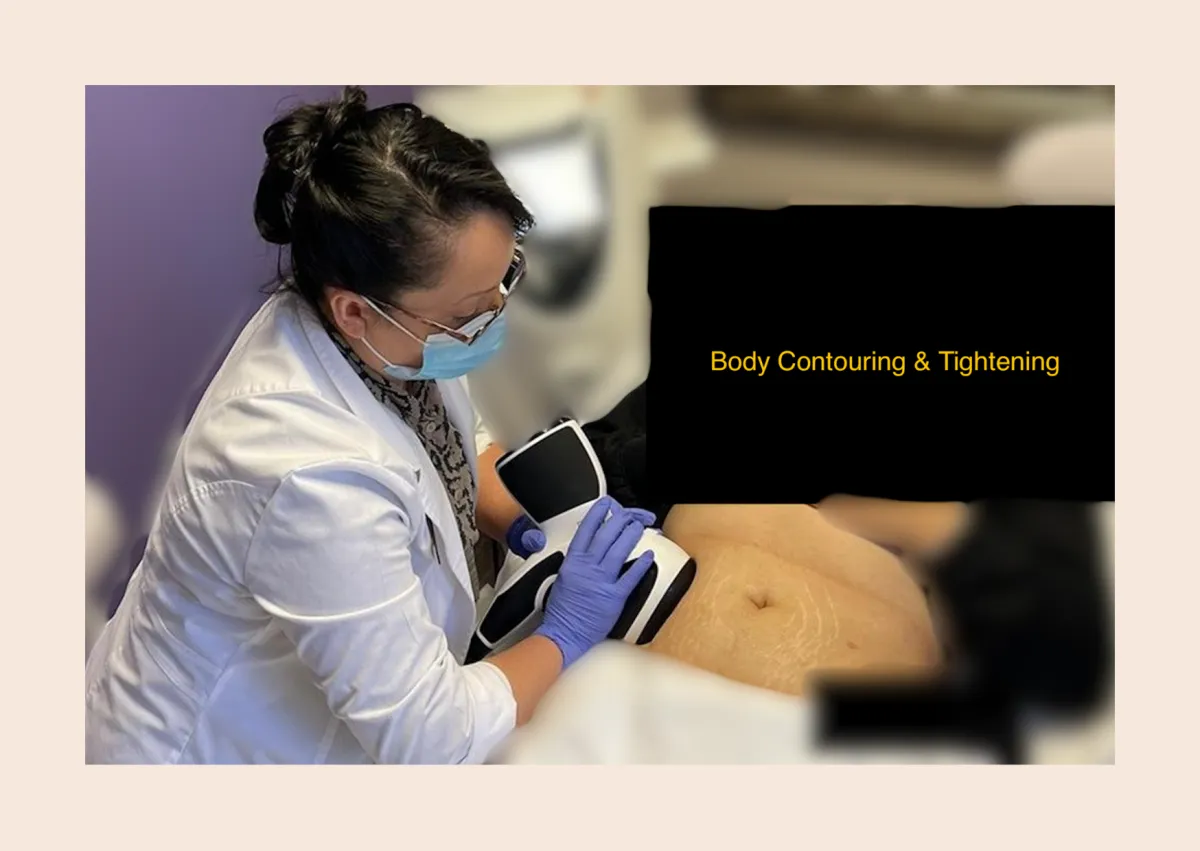(860) 370-5978
Revive Your Natural Beauty With Margarita
Licensed Esthetician in Suffield, CT
Helping you look great and feel confident in your own skin.
SKIN CARE DOESN'T HAVE TO BE STRESSFUL OR COMPLICATED
My approach is to create a personalized treatment plan tailored to your specific needs and goals. Whatever your skincare goals are (to control acne, reduce the effects of aging, help treat rosacea, hyperpigmentation, scar reduction and more...). I'm personally committed to helping you get the results you're looking for.
ADVANCED SKIN CARE TREATMENTS IN SUFFIELD, CT
Margarita provides you with a combination of customized skincare treatments and the most innovative
technologies in Western New England, to help you look great and feel confident in your own skin.
WHY CHOOSE MARGARITA
EDUCATION
Through continued education and training Margarita offers new innovative skin treatments and techniques.
SAFETY & CLEANLINESS
All services are performed to the highest ethical and professional standards, adhering to the strictest health and safety guidelines.
EXPERTISE
Over 24 years of experience performing thousands of professional skin care treatments on thousands of clients.
PRIVACY
Enjoy one-on-one personalized attention in a tranquil and entirely private environment just for you.
KNOWLEDGE
Margarita will come up with customized solutions to meet your specific skin care needs.
RESULTS
Margarita utilizes the latest equipment, tools and non-invasive technologies to bring you immediate visible results.
TESTIMONIALS
BEAUTY TIPS BY MARGARITA

How to Master SEO Essentials in 5 Steps
How to Master SEO Essentials in 5 Steps
Establishing a robust online presence is paramount for the success of both businesses and individuals. Central to achieving this digital prominence is the mastery of Search Engine Optimization (SEO) essentials.
This comprehensive guide is crafted to be your companion, providing a detailed roadmap through the fundamental steps required to elevate your online visibility and carve out a distinct identity in the competitive online domain.
Whether you are a business aiming to enhance your reach or an individual seeking to bolster your personal brand, the insights and strategies presented here will empower you to navigate the intricacies of SEO and effectively position yourself or your venture for success in the dynamic online world.
1. Understanding the Basics of SEO

Source: medium
a. Definition and Importance of SEO:
SEO involves optimizing a website or online content to enhance its visibility on search engines like Google. In simpler terms, it means strategically modifying your website and content to increase the chances of appearing in search results when relevant keywords are entered.
The significance of SEO is paramount in today's digital age. With millions of websites competing for attention, search engines act as the primary gateway for users to discover information, products, and services. A well-executed SEO strategy ensures not only the discoverability but also the high ranking of your content in search results, thereby increasing the likelihood of attracting organic traffic. Whether you're running a business, managing a blog, or promoting a personal brand, grasping and applying SEO practices is essential for establishing a robust online presence.
b. Key Components of SEO:
SEO is a multifaceted approach that encompasses various elements to enhance a website's visibility and ranking on search engines. The key components include:
1. Keyword Research: Identifying and targeting relevant keywords that your target audience is likely to use in search queries.

Source: Helium SEO
2. On-Page Optimization: Optimizing individual web pages to improve their content, meta tags, and overall structure. This involves optimizing title tags, meta descriptions, headers, and integrating relevant keywords.

Source: Hl Global Marketing
3. Content Quality: Creating high-quality, valuable, and engaging content that meets the needs of your audience. Content is a critical factor in SEO, and search engines prioritize websites that offer valuable information.

Source: SISTRIX
4. Backlinks: Building a strong backlink profile by acquiring quality inbound links from reputable websites. Backlinks are pivotal in establishing a website's authority and credibility.

Source: Shoutmeloud
5. Technical SEO: Ensuring that your website is technically sound, including aspects like site speed, mobile-friendliness, secure connections (HTTPS), and proper indexing of pages.

Source: Pinterest
6. User Experience: Improving the overall user experience on your website, including easy navigation, clear calls-to-action, and a mobile-responsive design.

Source: Forbes
Understanding and strategically implementing these key components will lay the foundation for a robust SEO strategy, driving organic traffic and improving your online visibility over time. As we delve deeper into each aspect, you'll gain actionable insights to effectively optimize your website for search engines.
2. Conducting Keyword Research

Source: Helium SEO
a. Importance of Keywords in SEO:
Keywords are the foundation of SEO, guiding search engines in understanding and ranking content. They represent the phrases users input to find information. Significantly, keywords link your content to the queries of your audience, enhancing visibility in search results.
Strategic use of relevant keywords in content, meta tags, and on-page elements signals to search engines the value and relevance of your content, resulting in increased visibility and organic traffic.
b. Tools for Effective Keyword Research:
Conducting thorough keyword research is a crucial step in any SEO strategy, and several tools can aid in this process. Here are some widely used tools for effective keyword research:
1. Google Keyword Planner: This free tool by Google provides insights into search volumes, competition, and suggests relevant keywords based on your industry or niche.
2. SEMrush: A comprehensive SEO tool that offers keyword research, competition analysis, and insights into your competitors' strategies.
3. Ahrefs: Known for its backlink analysis, Ahrefs also provides robust keyword research features, helping you identify high-performing keywords and analyzing your competitors' strategies.
4. Ubersuggest: This tool provides keyword ideas, search volume data, and insights into the competition for specific keywords.
5. KeywordTool.io: It generates long-tail keyword suggestions based on Google's autocomplete feature, providing valuable insights into user search behavior.
c. Long-tail Keywords and their Significance:
Long-tail keywords, consisting of three or more specific words, play a vital role in a well-rounded SEO strategy, complementing short, generic keywords. Despite having lower search volumes, these phrases indicate higher user intent and conversion potential.
Targeting long-tail keywords is valuable for capturing niche audiences actively seeking specific information or products. Users typing in long-tail queries are often closer to the decision-making stage, making these keywords essential for businesses aiming to attract motivated and relevant traffic.
Incorporating a mix of short and long-tail keywords into your content strategy enhances visibility across various search scenarios, contributing to a more effective and targeted SEO strategy. As we explore keyword research intricacies, gain insights into leveraging these tools and techniques to optimize your content for impactful keywords in your industry.
3. On-Page Optimization Techniques

Source: Hl Global Marketing
a. Title Tags and Meta Descriptions:
Title tags and meta descriptions are critical components of on-page optimization, serving as concise yet powerful elements that influence both search engine rankings and user engagement.
Title Tags: Title Tags are HTML elements defining a webpage's title. Crafting compelling tags is crucial for SEO as search engines use them to understand content. Including primary keywords improves visibility, and a well-crafted tag entices users, making it vital for both SEO and user experience.
Meta Descriptions: While not a direct ranking factor, meta descriptions provide a brief summary of a webpage's content. An enticing meta description can increase the click-through rate from search engine results pages (SERPs). It's an opportunity to showcase the value of your content and encourage users to visit your site.
b. Header Tags (H1, H2, H3):
Header tags, ranging from H1 to H6, are used to structure the content on a webpage. Among these, H1 is typically reserved for the main title of the page, while H2 to H6 represent subheadings in descending order of importance.
H1 Tag: The main title of the page should be wrapped in an H1 tag. This tag signals the topic or main theme of the content to search engines.
H2 to H6 Tags: These tags help organize the content hierarchically. Proper use of header tags makes the content more readable and provides search engines with additional context about the structure and importance of different sections.
c. URL Structure Optimization:
URL structure is a fundamental aspect of on-page SEO, contributing to both user experience and search engine readability.
Short and Descriptive: Create URLs that are concise, easy to read, and convey the content's topic. Avoid using complex strings of numbers or irrelevant characters.
Include Keywords: Incorporate relevant keywords in the URL, particularly in the slug (the part of the URL after the domain). This helps search engines understand the content and contributes to better ranking.
Hyphens for Separation: Employ hyphens (-) to distinguish between words in the URL.This enhances readability and ensures that search engines recognize individual words.
d. Image Optimization:
Images are essential for engaging content, but they also need optimization for SEO purposes.
Alt Text: Provide descriptive and keyword-rich alt text for each image. Alt text not only helps search engines understand the content of images but also improves accessibility for users with visual impairments.
File Size and Format: Optimize image file sizes without compromising quality. Compressed images load faster, contributing to a better user experience and potentially improving search rankings.Utilize widely supported formats such as JPEG, PNG, or WebP.
Descriptive Filenames: Rename image files with descriptive, keyword-rich names before uploading them. This contributes to search engine understanding and can positively impact image search results.
By implementing these on-page optimization techniques, you not only enhance your website's search engine visibility but also improve the overall user experience. These elements work together to provide a clear and well-structured signal to search engines about the relevance and quality of your content. As we delve into each aspect, you'll gain actionable insights on optimizing your on-page elements for maximum impact.
4. Off-Page SEO Strategies

Source: Comrade Digital Marketing
a. Importance of Backlinks:
Backlinks, also known as inbound or incoming links, are links from external websites pointing to your site. In the realm of SEO, backlinks are like digital votes of confidence for your content. The importance of backlinks lies in their ability to significantly impact your website's authority, credibility, and overall search engine rankings.
Authority and Trust: Backlinks are regarded by search engines as endorsements. When reputable and authoritative sites link to your content, it signals to search engines that your content is both trustworthy and valuable. This, in turn, can contribute to an increase in your site's overall authority.
Enhanced Visibility: Backlinks play a crucial role in determining the position of your website in search engine results. Websites with a strong and diverse backlink profile are more likely to rank higher, leading to increased visibility and, consequently, more organic traffic.
Relationship Building: The process of acquiring backlinks often involves building relationships with other website owners and influencers in your industry. These connections can open doors to collaborations, partnerships, and other mutually beneficial opportunities.
b. Building High-Quality Backlinks:
While the quantity of backlinks is a factor, the quality of those links holds greater significance. Establishing top-notch backlinks necessitates a methodical and ethical strategy.
Content Quality: Create high-quality, valuable content that naturally attracts links. Compelling and informative content is more likely to be shared and linked to by other websites in your niche.
Guest Posting: Contribute guest posts to authoritative websites within your industry. This not only exposes your content to a wider audience but also allows you to include relevant backlinks within your author bio or content.
Broken Link Building: Spot broken links on other websites and propose your content as a substitute. This tactic is a win-win, as it helps the website owner fix broken links while providing you with a valuable backlink.
Social Media Sharing: Proactively distribute your content across social media platforms. While social signals themselves may not directly impact rankings, increased visibility can lead to more organic sharing and, consequently, more backlinks.
Influencer Outreach: Build relationships with influencers and thought leaders in your industry. When these influencers recognize and appreciate your content, they may share it with their audience, providing valuable backlinks.
Directory Listings: Register your website with pertinent and trustworthy online directories. This not only helps with backlinks but also improves your online visibility and credibility.
c. Social Media Signals and SEO:
In the era of digital interconnectedness, social media signals are becoming increasingly relevant in the SEO landscape. While not direct ranking factors, social media signals can indirectly impact your website's visibility.
Increased Brand Awareness: Active engagement on social media platforms contributes to increased brand visibility. The more visible your brand, the more likely users are to search for and click on your website.
Content Amplification: Social media platforms serve as amplifiers for your content. When users share, like, or comment on your content, it reaches a broader audience, potentially attracting more organic traffic.
Potential for Backlinks: Social media provides a platform for content discovery. When influencers or other websites discover your content on social media, it may lead to them linking to your website, creating valuable backlinks.
Social Proof and Trust: A strong social media presence can contribute to building trust with your audience. Positive social signals, such as a high number of followers and engagement, can indirectly influence how search engines perceive your brand.
By incorporating social media signals into your overall off-page SEO strategy, you create a holistic approach to online visibility. As we delve into each strategy, you'll gain actionable insights into building a robust off-page SEO profile that encompasses both backlinks and social media signals.
5. Technical SEO Best Practices

Source: Reliablesoft
a. Site Speed Optimization:
Site speed is a critical factor influencing user experience and search engine rankings. Optimizing your website for speed not only enhances user satisfaction but also aligns with search engine algorithms that prioritize fast-loading pages.
Page Load Times: Minimize page load times by optimizing images, leveraging browser caching, and reducing unnecessary code. Quicker loading pages enhance user experience positively and may lead to improved search engine rankings.
Content Delivery Network (CDN): Utilize a CDN to distribute your website's static assets across servers worldwide. This reduces latency and ensures that users from different geographical locations experience faster load times.
Compression Techniques: Compress images and files to reduce their size without compromising quality. Gzip compression, for example, can significantly decrease the amount of data transferred, leading to quicker page loads.
Minimize HTTP Requests: Decrease the elements on a page that necessitate individual HTTP requests. Combining CSS and JavaScript files, as well as using CSS sprites for images, can streamline the loading process.
b. Mobile-Friendly Design:
Given the rising prevalence of mobile devices, having a mobile-friendly website is no longer a choice but a necessity. Search engines give priority to mobile-friendly websites in their rankings to guarantee a positive user experience for mobile users.
Responsive Design: Integrate a responsive design that adjusts to diverse screen sizes and resolutions. This ensures that your website looks and functions seamlessly across desktops, tablets, and smartphones.
Mobile Page Speed: Optimize your website's mobile page speed. Mobile users often have different expectations and slower internet connections, making fast-loading pages crucial for retaining their attention.
Touch-Friendly Elements: Design touch-friendly elements for mobile users. Ensure that buttons are appropriately sized and spaced to prevent accidental clicks and enhance overall usability.
Mobile-Optimized Content: Tailor your content for mobile consumption. Consider shorter paragraphs, concise headlines, and easily scannable content to accommodate users on smaller screens.
c. XML Sitemaps and Robots.txt:
XML sitemaps and robots.txt files play vital roles in guiding search engine crawlers and ensuring that your website's content is appropriately indexed.
XML Sitemaps: Generate and submit XML sitemaps to search engines.These files provide a roadmap of your website's structure, helping search engines understand the organization of your content and ensuring that all pages are crawled and indexed.
Robots.txt: Use the robots.txt file to instruct search engine crawlers on which areas of your site to crawl and which to avoid. This file helps prevent the indexing of sensitive or irrelevant pages, ensuring that search engines focus on your most important content.
Regular Updates: Keep your XML sitemaps and robots.txt files updated. As your website evolves, these files should accurately reflect the current structure and directives to ensure optimal crawlability.
By implementing these technical SEO best practices, you not only enhance your website's performance and user experience but also align with search engine algorithms that prioritize well-optimized and user-friendly websites. As we explore each practice in detail, you'll gain practical insights into implementing these techniques effectively for improved technical SEO.
Conclusion:

Source: Medium
By mastering the SEO essentials provided in this guide, you'll be well-prepared to boost your online visibility and attract organic traffic to your website. Keep in mind that SEO is a continuous process, so stay dedicated to refining your strategies as search engine algorithms evolve. Elevate your online presence and outshine the competition with these practical tips and techniques. Start implementing these strategies today, and watch your online visibility soar!
HELPING YOU ACHIEVE HEALTHIER, YOUNGER-LOOKING SKIN
There are countless skincare regimens, facial products and advice out there, which can be confusing and frustrating when you are not seeing successful results. Many over-the-counter treatments that claim to perform results fail to follow through, costing you a ton of money and leaving you disappointed.
We know how damaged, aging skin can have a huge impact on your confidence and self-esteem. Margarita treats all different skin types and conditions. Margarita is currently located in Suffield, Connecticut working in collaboration with nurse Practictioner Julyvette Rodriguez. Cara Mia Medical Spa provides a combination of cutting edge technologies with non-invasive rejuvenating treatments, and use only high quality medical grade products and well-known botanical products to leave you with healthy, glowing skin.
SCHEDULE A VIRTUAL SKIN CARE CONSULTATION
Get personalized one-on-one skin care coaching with Margarita
PROFESSIONAL SKIN CARE PRODUCTS
Margarita has partnered with various world-renowned skincare leaders in the industry. Discover a complete range of pure medical grade products designed to keep skin looking youthful and healthy.

Want to get the scoop on exciting new services, exclusive offers, giveaways and more before anyone else?
Signup below.
MY MISSION
To provide my clients with customized non-invasive skin care treatments to improve the health and beauty of their skin so they look great and feel confident in their own skin.
CONTACT INFO
PHONE: (860) 370-5978
EMAIL: [email protected]
BY APPOINTMENT
Wednesday: 9 a.m. to 6 p.m.
Thursday: 9 a.m. to 6 p.m.
Friday: 9 a.m. to 3 p.m.
Late appointments available Wednesdays & Thursdays upon request.
CURRENTLY SERVICING AT:
66 N. Main Street
Ground Level
Suffield, CT 06078
SERVICES
Chemical Peels
Gentlemen's Skin Care
Hair Removal
Microneedling
Skin Rejuvenation
Body Contouring
Custom Facials
Virtual Consultation
FOLLOW ME
MargaritaTheEsthetician








